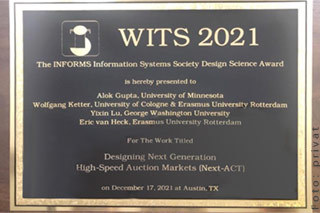At the crack of dawn, when the Dutch Flower Auction begins in the small coastal town of Naaldwijk, the ticking of the auction clocks suddenly seems louder. Bids from interested buyers flow in from onsite as well as remote sources via an online system. Huge sums of money are spent in seconds. As many as 22,000 trolleys containing buckets of flowers are moved in and out of the massive operations at the Royal FloraHolland growers’ cooperative each day. Any effort at efficiency can translate to significant value for sellers and buyers.
A team led by WiSo Professor Wolfgang Ketter developed technology to support these experts in agriculture to achieve such gains. As a result, their research project "Designing Next-Generation High-Speed Auction Markets (Next-ACT)". was awarded the prestigious INFORMS Design Science Award in December 2021, during the Workshop on Information Technologies and Systems (WITS).
Technological advances in recent decades have improved the efficiency of transactions of goods and services, but they have also brought significant challenges for market designers and operators. Due to cognitive limitations, market participants are unable to adequately process all available information to make informed decisions, which can harm the performance of a market. Wolfgang Ketter (University of Cologne), Alok Gupta (University of Minnesota), Yixin Lu (George Washington University), and Eric van Heck (Erasmus University Rotterdam) have now tackled this problem with automated decision-making support in real-time, supported by artificial intelligence.
In cooperation with Royal FloraHolland, the largest flower auctions worldwide, the team developed so-called IT artefacts that optimise the flow of information and the decision-making process in the market. Overall, they designed, developed and implemented five artefacts: a stable taxonomy of bidding strategies, a flexible framework for decision support, a new auction and bidding interface, a hybrid auction mechanism that mitigates market congestion, and an auction simulation system.
These IT artefacts facilitate decision-making in information-rich and time-critical B2B auction markets. Laboratory and field testing preceded implementation of the mechanisms in the auction and required close cooperation of the researchers with the world's largest wholesale flower market. As a result, the work processes can also be conferred to other B2B markets.
WiSo Professor Ketter and colleagues’ recipients of INFORMS Design Science Award…
